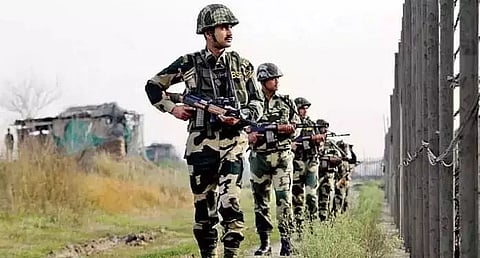
- Home
- Live Blog
- Breaking News
- Top Headlines
- Cities
- NE News
- Sentinel Media
- Sports
- Education
- Jobs

Nearly eight years after the inception of the Integrated Check Post (ICP), Agartala, the largest-ever consignment of 1320 MT of wheat to Bangladesh through this ICP on August 8 signalled the Northeast region gaining importance in deepening bilateral engagement between India and Bangladesh. The export consignment in 67 trucks valued at 3,78,00 US dollars is also a pointer of huge benefits for the region along the export value chain from such cross-border trade. Ahead of this consignment Muhammad Imran, High Commissioner of Bangladesh to India, and Land Ports Authority of India (LPAI) Chairman Aditya Mishra met LPAI headquarters on July 26 and discussed the crucial role and significance of India-Bangladesh trade via ICPs. Earlier, a visit by a team of officials of the Ministry of Home Affairs to Tripura to take stock of the operation of ICP Agartala and inspection of a site location in Sabroom for a proposed ICP on the Tripura-Bangladesh border gave a push to cross-border trade through land ports in the region. After ICP Sabroom is developed, it will be the third ICP in Tripura after ICP Agartala and ICP Srimantapur. Expediting setting up an ICP at Sabroom is expected to witness high volume bilateral trade between the two neighbouring countries as the border town in Tripura has direct connectivity with Chittagong Port in Bangladesh after India completed construction of a bridge over river Feni flowing across the international border. The distance between Sabroom and Chittagong port is only 72 km through this double-lane bridge, named Maitree Setu. Inauguration of the bridge restored access of the northeast region to the sea and deepening bilateral relations between India and Bangladesh has opened up huge opportunities of ending the landlocked situation of the region, through this route. Multimodal connectivity of highway, railway, and sea routes through the proposed ICP Sabroom will establish connectivity with Southeast Asian nations. It also cuts down the distance of any place of the northeast region to sea from 72 km to 600 km against the existing distance of the region to the sea which ranges from 600 km to 1200 km through the Haldia port in West Bengal. Prime Minister Narendra Modi laid the foundation stone of ICP Sabroom and inaugurated Maitree Setu on March 9 through a video conference. He expressed confidence that Agartala will emerge as an important centre for logistics across the Northeast and the route will cut down transport costs and the entire Northeast region will get the goods easily. For Bangladesh, the bridge will not only facilitate trade with India but also with Bhutan and Nepal through India's Northeast region. Bangladesh's increasing trade relations with Bhutan and Bangladesh through Maitree Setu is going to make ICP Sabroom as well as ICP Agartala commercial and logistic hubs of international trade in South and Southeast Asia. Smooth access to the seaport from the northeast region is expected to shape a new narrative for industries and investors eyeing markets in South and Southeast Asia. Such narratives will replace the image of North-eastern states as a landlocked region which has been posing obstacles to investments in the region for industries despite sops such as capital and transport subsidies offered by the central government in its North East Industrial Development Scheme as well as by the states in their industrial policies. The low volume of current trade between India and Bangladesh is also indicative of the huge potential for enhancing trade and commerce between the two neighbouring countries through existing and proposed ICPS near the international border. World Bank estimates show that the current volume of bilateral trade is only 10 per cent of total trade in Bangladesh and only one per cent of total trade in India. The Neighbourhood First policy of India has provided the cushion for both countries to increase bilateral trade. Cross-border movement of people between the two countries under this policy and through the land routes will boost tourism and create huge livelihood opportunities. However, India and Bangladesh signing motor vehicle agreements are critical to seamless connectivity of passenger transport and cargo movement through the land ports in the region. Existing ICPs at Agartala and Srimantapur besides the proposed ICP at Sabroom have brought huge opportunities not just for producers in Tripura but for all other states in the region. Benefiting from such opportunities will require states to improve connectivity to Tripura for smooth movement of cargo and people. The chain of economic activities along the highways in the region from different states to these ICPs due to the movement of cargo and people as well as from Bhutan and Nepal has the potential to accelerate growth in the economy in the entire northeast region. It will also create new livelihood opportunities and ignite new dreams of entrepreneurship in the region with a high potential for export business. Enhanced trade through ICPs on the India-Bangladesh border can unshackle the northeast region from decades of underdevelopment.